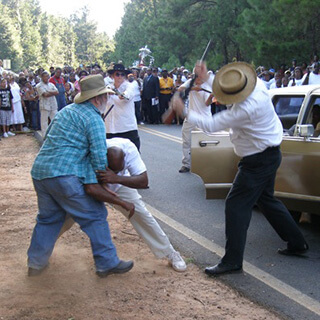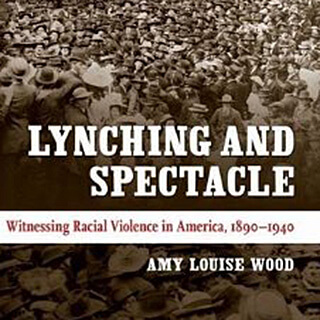Overview
Amy Louise Wood reviews Troubled Ground: A Tale of Murder, Lynching, and Reckoning in the New South by Claude A. Clegg, III (Urbana: University of Illinois Press, 2010).
Review
 |
| Rowan County Court House and Jail, Salisbury, North Carolina, circa 1905-1915. Courtesy of the Durwood Barbour Collection of North Carolina Postcards, North Carolina Collection, University of North Carolina at Chapel Hill. |
On an August evening in 1906, a white mob stormed the county jail in Salisbury, North Carolina, seeking six black prisoners indicted that day for the brutal murder of four members of a local white farming family, the Lyerlys. The judge overseeing the case had called in a local military company to protect the jail and restrain the mob, but the soldiers did little to prevent the raid, refusing to fire their guns. Once inside, the mob freed all the white prisoners, roughed up and "interrogated" the suspects, and then absconded with three of them—Jack Dillingham, Nease Gillespie, and his son John. They marched them to a field, hanged them from a tree, molested and tortured their bodies, and riddled them with bullets. It was the first triple lynching in the state since 1888, and the second lynching in Rowan County in just four years. In 1902, the county had drawn national attention when a mob lynched James and Harrison Gillespie (of the same Gillespie family), aged eleven and thirteen, for allegedly murdering a young white woman as she hoed corn on her family's farm. Troubled Ground is a captivating retelling of these brutal events and a judicious meditation on their larger significance for the history of racial violence in America.
 |
| Map showing Salisbury, North Carolina, 2012. |
So many local or case studies of Jim Crow-era lynchings have been published during the past twenty years, that they now comprise their own subgenre of the larger field of lynching studies. Their appeal is obvious: they recount dramatic stories of crime, revenge, and violence, set against the backdrop of the era's political and social turmoil. But they have a larger importance. Case studies provide corroboration for macro studies that attempt to generalize about lynching, its causes and effects. They bring much needed texture and intimacy to our understanding of racial violence. Moreover, they remind us of how much the practice of lynching was contingent upon local factors and the specificities of time and place. Every lynching or near-lynching played out and was responded to in a slightly different way, depending on the circumstances, the people involved, and the local and state political climate. Case studies also remind us of how similar lynchings were across time and geography. We find patterns—the composition of mobs, the rituals they engaged in, the rhetoric used to defend the violence, and the tragic resonance of the violence. Pieced together, these local studies provide a mosaic that illustrates the tragedy of lynching in this country. Up close, each story is unique and particular, but as we pull back, the larger picture emerges.
 |
| Cover of Troubled Ground: A Tale of Murder, Lynching, and Reckoning in the New South, 2010. |
Troubled Ground is an excellent addition to this subgenre. Beautifully narrated, it is rich in detail and nuance, while also attentive to the larger context surrounding the story. Its author, Claude Clegg, grew up in Rowan County, providing an added personal dimension. He was drawn to this story because neither he nor his parents knew anything of these lynchings, which had attracted national attention, despite the fact that his family had lived in the area for generations. A significant purpose of this book was to "excavate" (p. xv) this story from the "troubled ground" in which it had been buried and to restore it to public consciousness.
In telling these hometown stories as history, Clegg makes the case that Rowan County was an exceptional place, with "its own internal dynamics and unique history" (54), and a typical place, characterized by factors and patterns that made it fertile ground for racial violence. Throughout, Clegg emphasizes themes that illuminate the wider history of Jim Crow lynching. He reaffirms how the Rowan lynchings served to support the implementation of segregation and disenfranchisement at the turn of the century by creating an atmosphere of terror for local blacks and hardening the boundaries between whites and blacks. As other historians have done, Clegg also situates these lynchings within a process of modernization that was occurring in the county. Salisbury, the county seat, was a rural town, but, not unlike other localities in which lynchings occurred, it was undergoing a process of change into a "New South" city. In the late nineteenth century, the population had grown alongside new factories, mills, and other industrial businesses. The town experienced the development of new public works and utilities, restaurants and hotels, schools and churches. Replete with ambiguity and tension, Salisbury's urbanization did not preclude racial oppression.
 |
| Main Street, Salisbury, North Carolina, circa 1910. Courtesy of the Durwood Barbour Collection of North Carolina Postcards, North Carolina Collection, University of North Carolina at Chapel Hill. |
Clegg calls attention to the ways in which civic and political leaders were implicated in the practice of lynching. Through the complicity of these elites, the violence of lynching became "institutionalized" (p. xvi). He highlights the roles of New South politicians Charles Aycock and Robert Glenn, elected as Democratic governors in 1900 and 1904. Throughout, Clegg skillfully maneuvers between telling the stories of these lynchings as they were experienced by members of white and black communities, and from the top down—from the perspective of Aycock and Glenn. Both governors came to power by engaging in rabid pro-lynching race-baiting to stamp down the cross-racial alliances created by the Fusionists in North Carolina, the coalition between the Republican and Populists Parties that in previous elections had undermined Democratic hegemony. Once in power, Aycock and Glenn adopted progressive goals and sought to elicit northern investment into the state by making white supremacy respectable. This led them to decry the kinds of racial violence they had fomented when running for office. Clegg brings out the irony of this dynamic nicely as the public responses to the 1902 and 1906 lynchings played out in surprising ways that "amended the conventional lynching script" (137).
Although, here and there, Clegg might have credited his reliance upon other scholars more fully, he tells a suspenseful story while engaging in sharp analysis. Troubled Ground is a masterful work of local history. 
Recommended Resources
Brundage, W. Fitzhugh. Lynching in the New South: Georgia and Virginia, 1880–1930. Chicago: University of Illinois Press, 1993.
Dray, Philip. At the Hands of Persons Unknown: The Lynching of Black America.New York: Random House, Inc., 2002.
Pfeifer, Michael J. Rough Justice: Lynching and American Society, 1874–1947. Urbana: University of Illinois Press, 2004.
Waldrep, Christopher. The Many Faces of Judge Lynch: Extralegal Violence and Punishment in America. New York: Palgrave Macmillan, 2002.
Wood, Amy Louise. Lynching and Spectacle: Witnessing Racial Violence in America, 1890–1940. Chapel Hill: University of North Carolina Press, 2009.
Links
Allen, James. Without Sanctuary: Photographs and Postcards of Lynching in America.
http://www.withoutsanctuary.org/main.html.

